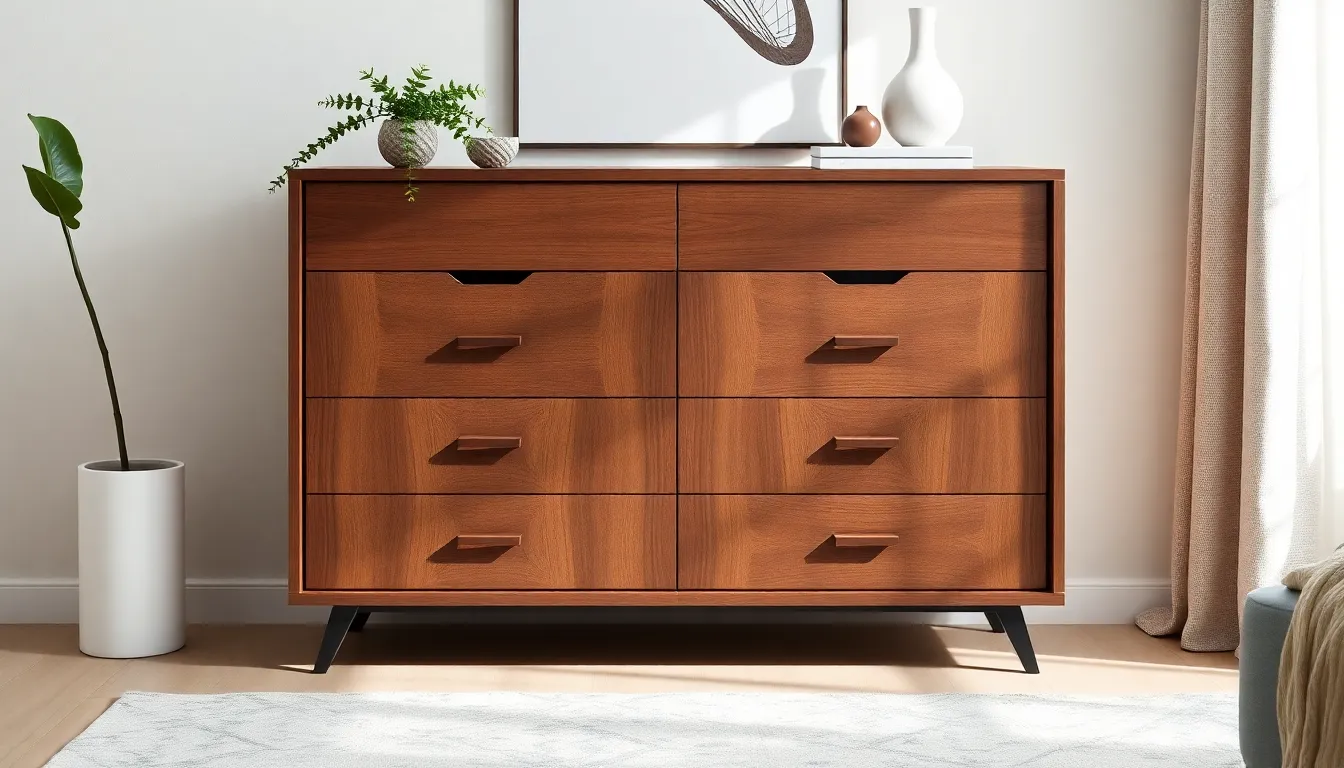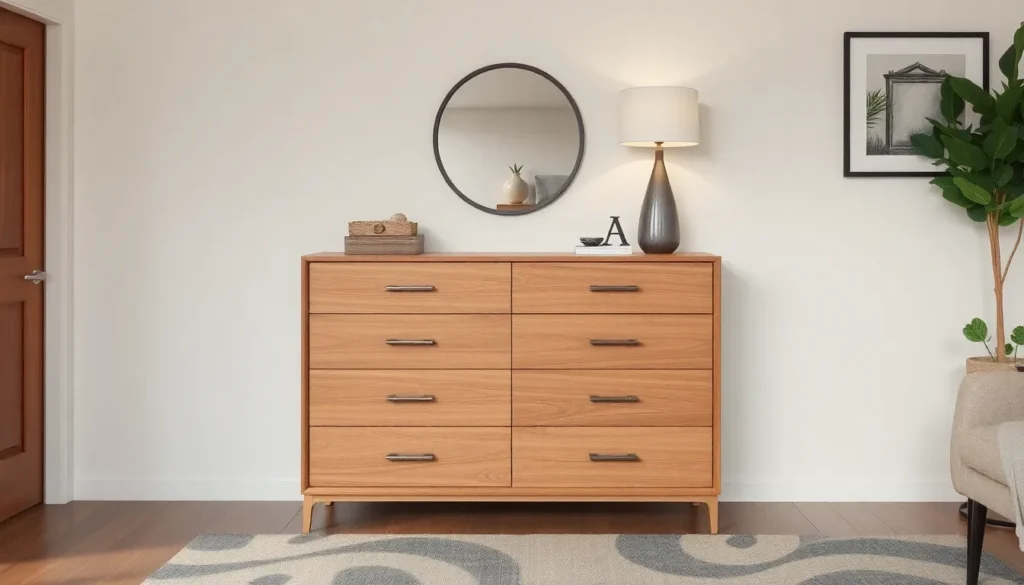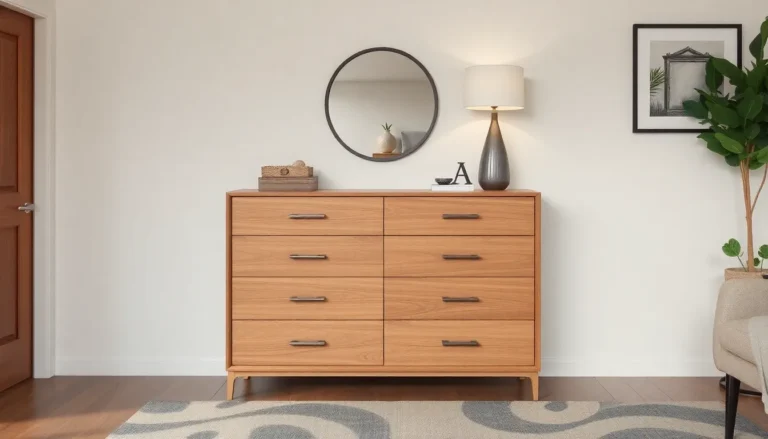Table of Contents
ToggleDressers are more than just furniture; they’re the unsung heroes of home organization. Imagine a world where socks don’t wage war with each other and shirts don’t mysteriously vanish into the abyss. With the right dresser, chaos turns into harmony, and getting dressed becomes a delightful experience instead of a scavenger hunt.
Overview of Dressers
Dressers serve as vital components in home organization. These furniture pieces provide storage for clothing, accessories, and personal items. Such functionality helps maintain an orderly space, significantly contributing to a more streamlined daily routine.
Essential features of dressers include multiple drawers, which allow for the categorization of items. Many dressers come equipped with varying drawer sizes, catering to different storage needs. Shallow drawers suit items like undergarments and accessories, while deeper drawers accommodate bulkier clothing.
Materials used in dresser construction vary widely, with wood and engineered wood being popular choices. High-quality wood options offer durability and aesthetic appeal, bringing warmth to a room. Additionally, some dressers incorporate metal or glass elements, adding a contemporary touch to traditional designs.
Style options abound, making it easy to find a dresser that complements existing decor. Rustic, modern, and minimalist styles are just a few examples of available designs. Each style presents unique characteristics, such as distressed finishes or clean lines, enhancing the overall ambiance of a space.
Configurations also differ significantly among dressers. Standard options feature drawers only, while some designs include additional elements like mirrors or shelving units. Such configurations maximize functionality, transforming a simple storage unit into an essential dressing station.
Selecting the right dresser involves considering functionality, design, and material. By choosing a dresser that aligns with personal preferences and room aesthetics, individuals can enhance their living spaces while ensuring efficient organization.
Types of Dressers

Various types of dressers cater to different styles and needs in home organization. Understanding these options helps in selecting the best fit for a living space.
Traditional Dressers
Traditional dressers feature classic designs characterized by ornate detailing and rich finishes. These pieces often include multiple drawers with various sizes, ideal for organizing clothing and accessories. Made from solid wood or high-quality materials, they enhance the timeless charm of bedrooms. Often, traditional dressers come with mirrors that add functionality while creating an illusion of space. As a result, they suit styles ranging from vintage to eclectic, appealing to those who appreciate classic aesthetics.
Modern Dressers
Modern dressers showcase sleek lines and minimalist designs, focusing on functional elegance. Often crafted from engineered wood or metal, these dressers integrate well into contemporary homes. Drawers usually feature smooth, handle-less fronts, reflecting a clean aesthetic. Available in various colors and finishes, they offer versatility in styling. When combined with other furniture pieces, modern dressers enhance a cohesive look in any room.
Chest of Drawers
Chest of drawers serve as a vertical storage solution for compact spaces. Typically, this style includes several narrow drawers stacked vertically, maximizing floor space. Utilizing various materials, chests often range from heavy woods to lighter engineered options. Their design varies widely, from rustic wooden finishes to sleek, modern surfaces. This versatility ensures they fit seamlessly into a range of decor styles while efficiently housing clothing and accessories.
Materials Used in Dressers
Materials play a crucial role in the construction and durability of dressers, affecting both functionality and aesthetic appeal.
Wood Varieties
Hardwoods like oak, maple, and cherry are popular choices for dressers, known for their strength and longevity. Oak offers a grainy texture that adds charm, while maple brings a smooth finish ideal for modern designs. Cherry wood darkens gracefully over time, enhancing its rich color. Softwoods like pine and spruce are budget-friendly options, easy to work with and available in various styles. Each wood variety contributes unique characteristics, making it essential to consider the look and feel that best fits a home.
Manufactured Materials
Manufactured materials, including medium-density fiberboard (MDF) and particleboard, provide affordable and versatile alternatives to solid wood. These materials can mimic the appearance of wood through laminates or veneers, allowing for diverse design possibilities. MDF boasts a smooth surface, perfect for intricate designs, while particleboard offers lightweight construction. Both options play a significant role in modern dressers, combining affordability with effective use of space. Selecting the appropriate manufactured material ensures both durability and style in furniture design.
Design and Style Considerations
Selecting a dresser involves thoughtful attention to design and style elements that enhance functionality and aesthetics. Buyers should focus on how these aspects integrate into their living spaces.
Color and Finish
Choosing color and finish has a significant impact on a dresser’s overall look. Neutral finishes like white or gray provide versatility, seamlessly blending with various decors. Dark finishes like walnut or ebony offer sophistication, suitable for traditional or modern themes. Metallic accents also add a contemporary touch, enhancing visual interest. Selecting a color that matches existing furnishings or contrasts with them can create a striking focal point. Additionally, matte and glossy finishes each convey different styles. Glossy surfaces reflect light and evoke a modern vibe, while matte options lend warmth and a more rustic appeal.
Size and Space
Size matters when incorporating a dresser into a room. Measuring available space prevents selecting an overly large or small unit. Standard dressers generally range from 30 to 60 inches in width, accommodating different room layouts. Considerations should include drawer depth and height, as shallow drawers suit small items while deeper drawers accommodate bulkier apparel. Maintaining a clear pathway around the dresser allows for easy access and prevents clutter. Room dimensions dictate whether a low-profile dresser complements the space or a taller chest of drawers fits better. Every detail contributes to efficient organization and an aesthetically pleasing environment.
Care and Maintenance of Dressers
Maintaining a dresser ensures longevity and aesthetic appeal. Regular dusting with a microfiber cloth prevents dust buildup and keeps surfaces clean. For sticky residues, a damp cloth with mild soap works effectively.
Polishing wood dressers enhances their shine and protects the finish. Use products designed for wooden furniture, applying them sparingly to avoid buildup. Areas with scratches or dents benefit from specialized touch-up kits that blend with the finish.
Avoid placing dressers in direct sunlight, as ultraviolet rays can fade colors over time. When moving a dresser, lift rather than drag to prevent structural damage. Each drawer should operate smoothly, so check for alignment regularly.
Addressing minor repairs immediately prevents long-term issues. Tightening screws and hardware maintains sturdiness. Inspect for loose joints or signs of wear; early detection allows for easy fixes and preserves the dresser’s functionality.
Humidity can warp wood, so maintain a controlled environment. Ideal humidity levels range from 30% to 50%. When storing items in drawers, avoid overloading. Each drawer has weight limits that, if exceeded, may cause sagging or difficulty in operation.
Selecting the right cleaning products is essential. Harsh chemicals can damage finishes, so stick to pH-balanced cleaners. Keeping all surfaces dry prevents mold and mildew, particularly in damp environments.
Using felt pads under heavier items can prevent scratches on the surface. Keeping the dresser organized also helps maintain its condition. Overall, proper care extends the life of a dresser while preserving its role in home organization and aesthetics.
Choosing the right dresser can significantly enhance both organization and style in any living space. With various designs and materials available, it’s crucial to select one that fits personal needs and complements existing decor. A well-maintained dresser not only keeps clothing and accessories tidy but also adds character to a room. By considering functionality, size, and care tips, individuals can ensure their dresser remains a valuable asset for years to come. Investing in a quality dresser is more than just a purchase; it’s a step toward creating a more organized and aesthetically pleasing home environment.







